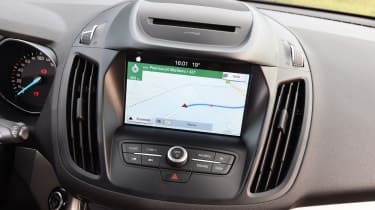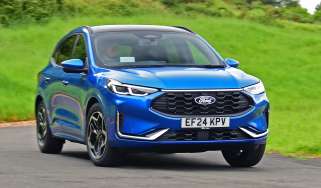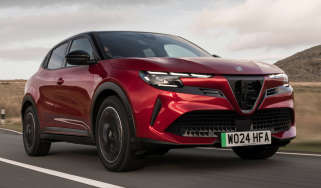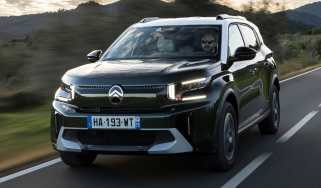Used Ford Kuga review: 2012 to 2019 (Mk2) - Interior, comfort and safety
The Ford Kuga is comfortable but the interior looks dated next to rivals of a similar age
The Ford Kuga provides plenty of comfort on the move, with a quiet interior that does an excellent job of isolating occupants from engine and road noise, but there's still quite a lot of wind noise when driving on the motorway.
While the ride is generally smooth, even when the biggest wheels are fitted, the styling and design of the interior is now feeling its age against newer rivals.
What’s the Ford Kuga like inside?
The quality and design of the Ford Kuga's interior looks fine in isolation, but suffers in comparison to its latest rivals, particularly the Peugeot 3008 and SEAT Ateca. The dashboard layout can look a little intimidating to start with, but the controls are well placed and intuitive to use. The switchgear itself is looking a little old-fashioned now, though, and older models have an unusual-looking dash covered in buttons that really looks dated now.
Later models got Ford’s SYNC 3 infotainment system as standard (on Titanium models and above). It incorporates a voice-activation system, which can be used to operate many of the car's systems, as well offering a range of clear and easy-to-read display screens. It's a little off the pace compared to the systems found in rival cars though. Apple CarPlay or Android Auto are available, which is good.
More reviews
Car trim reviews
In-depth reviews
- Ford Kuga review – a sharp-handling and efficient SUV
- Ford Kuga Plug-in Hybrid SUV review
- Ford Kuga SUV (2008-2012) review
Used car reviews
Although many of the materials are good, some scratchy, lightweight plastics can be found that cheapen the overall feel of the interior. This is worse on pre-facelift models.
The seats are supportive and comfortable, though, and it’s easy to find a good driving position – especially if they’re fitted with the optional electrical adjustment that our test car enjoyed.
What’s on the equipment list?
The Kuga launched with Zetec, Titanium and Titanium X trim levels, then Titanium X Sport was added in 2013 and ST-Line and Vignale were added in 2016. Ford also added the word “Edition” to certain trims when it tweaked the equipment list.
All Kugas come with a healthy amount of standard equipment: even the basic Zetec model has keyless start, 17-inch alloy wheels, DAB digital radio, air-conditioning, cruise control and a heated windscreen.
The Titanium Edition model adds half-leather trim, automatic lights and wipers, sat-nav, an eight-inch touchscreen and Ford's latest SYNC3 voice-activation system. Titanium X Edition adds 19-inch alloy wheels, a panoramic sunroof, heated leather seats with electric adjustment, bi-xenon headlights and LED rear lights, but this trim is almost £3,000 more expensive than Titanium.
Top-of-the-line Vignale models come with features such as a foot-operated boot release and are distinguished by their own special exterior body styling and 18-inch alloy wheels. Inside, they have a ‘tuxedo-stitched’ leather, a power-adjustable driver’s seat, ambient lighting and Sony speakers, plus many other luxury touches besides.
The sporty-looking ST-Line version adds unique 18- or 19-inch alloy wheels and an array of special trim finishes, both outside and in. Keen drivers will also appreciate the more responsive steering and better body control that the ST-Line’s chassis improvements offer. ST-Line Edition adds a panoramic sunroof, keyless entry, red brake calipers and a large rear spoiler for around £2,000 more than standard ST-Line.
How safe is it?
The Ford Kuga offers excellent crash protection and it received the maximum five-star rating when it was crash-tested by Euro NCAP. All Kugas come with skid-preventing electronic stability control, numerous airbags, a seatbelt warning buzzer for every seat and cruise control with a speed limiter.
Options to look out for include the Driver Assistance Pack, which includes autonomous braking, lane-keeping assistance, traffic-sign recognition (which displays roadside information on the dashboard), a blind-spot warning system, auto-dipping headlights and a driver-alert system that can detect if you're nodding off and suggest you take a break.
















